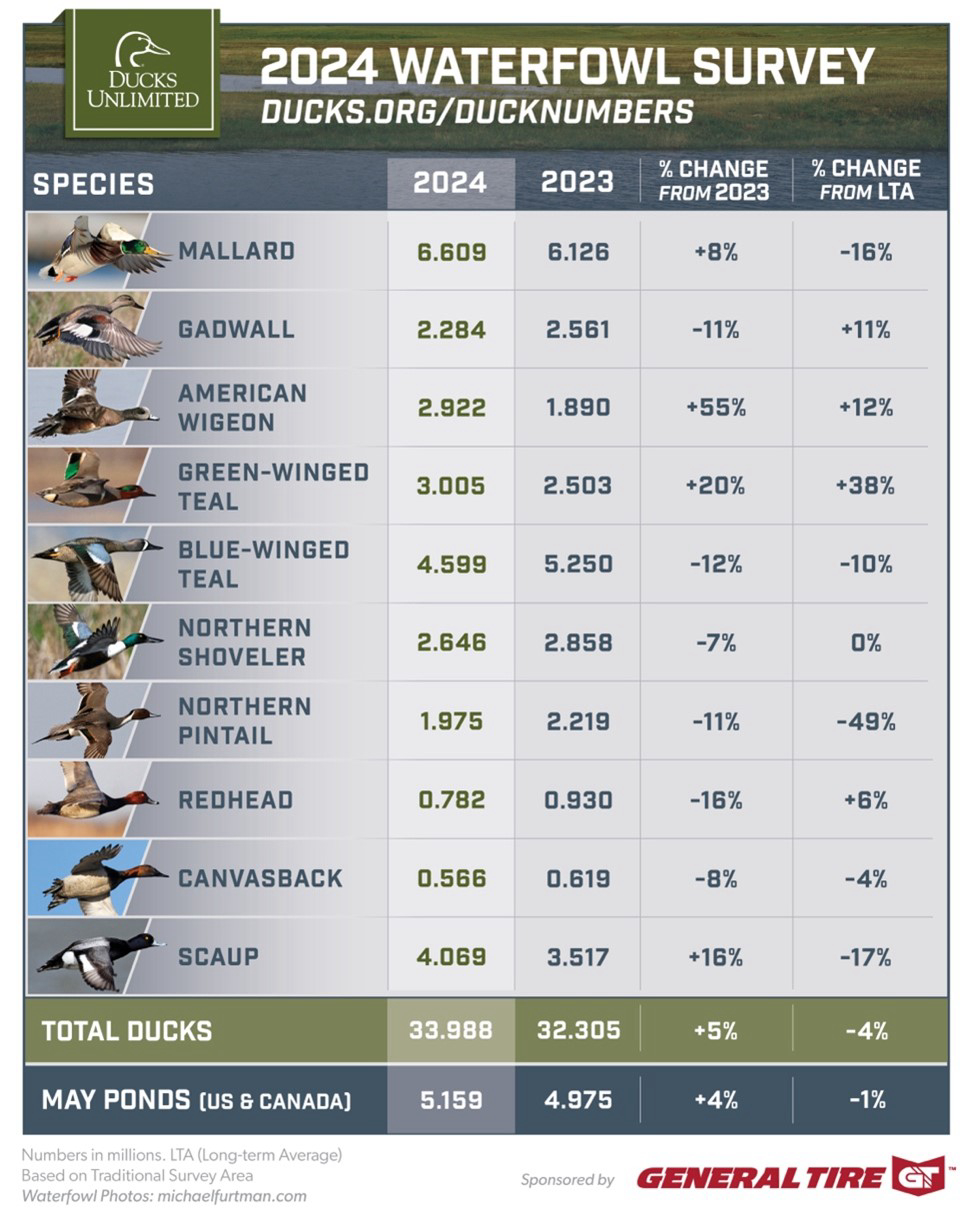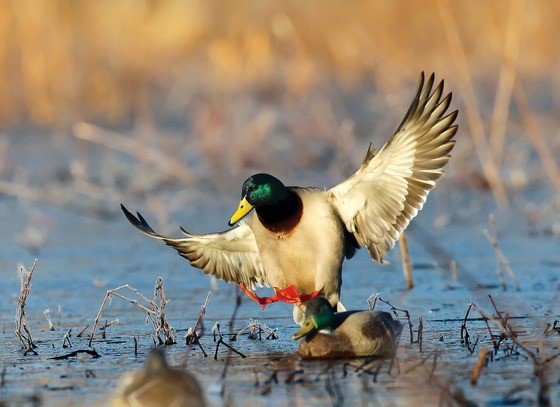2024 Waterfowl Population Survey Results
 |
A 5% increase in population estimates shows resiliency of duck populations amid prolonged drought
The U.S. Fish and Wildlife Service (USFWS) released its 2024 Waterfowl Population Status Report. This report contains results from surveys and population estimation methods conducted by the USFWS, Canadian Wildlife Service and numerous state and provincial partners.
The estimate for total breeding ducks in the traditional survey area was 34 million, a 5% increase from the 2023 estimate of 32.3 million, and 4% below the long-term average (since 1955). Mallards were estimated at 6.6 million, 8% above 2023, but 16% below the long-term average and among the lowest since the early 1990s.
Notably, the results mark the first increase in total surveyed breeding ducks since 2015.
“This year’s report suggests that some duck populations had better production last year than expected, with good carryover to spring of this year,” said Dr. Steve Adair, Ducks Unlimited chief scientist. “While estimates were down in the prairies, population levels were up in northern breeding regions. We heard reports of an early spring, with ducks migrating through when the prairies were still dry and likely overflying to the Boreal Forest. This is a pattern we’ve seen many times before, and it appears to have been the case again this year.”
Despite the increase from 2023, overall population levels remain below the long-term average, reflecting the continued effects of multiple years of drought in the Prairie Pothole Region.
However, the importance of conserving habitats across diverse geographies revealed its value, as breeding areas outside the prairies helped maintain or increase population levels for some species over 2023.
Results for the six most abundant species in the eastern survey area remained healthy, with most species estimates increasing from 2023.
Key 2024 Survey Takeaways
- 2024 marks the first documented increase (+5%) in year-to-year total surveyed breeding ducks in the traditional survey area since 2015.
- Mallards increased by 8% and wigeon numbers increased by 55%.
- Pintails were down 11% from 2023, but at a level that will provide the opportunity for a three-pintail daily limit in the 2025–26 hunting season under the recently approved interim pintail harvest strategy.
- Total pond estimates in the U.S. and Canadian prairies were 5.2 million, a 4% increase from 2023. Although rain in April and May fell too late to benefit early migrants, it should have improved conditions for late nesters and brood production.
- Alaska, British Columbia and other northern survey areas saw improved habitat conditions and noteworthy increases in breeding numbers.
- Eastern survey area duck numbers increased in five out of the six major species while mallards saw a small drop.
Pond Numbers
Mother Nature brought welcome rain back to large portions of the prairies. Despite a brief reprieve two years ago, the prairies again turned dry in 2023, and drought worsened through winter. Dry conditions prevailed entering spring 2024, but widespread rains in April and May created excellent wetland abundance in some areas. The total pond estimate in the U.S. and Canadian prairies was 5.2 million, up 4% from the 2023 estimate of 5 million. Some areas, such as Prairie Canada, were down 19% while the northcentral U.S. was up 49%, demonstrating the dynamic nature of this landscape.
“Although pond numbers fluctuated in some regions, rains that fell immediately prior to the survey boosted prairie pond numbers more than many anticipated,” Adair said. “Rains continued well after the surveys were conducted, bringing life-sustaining water to large portions of the prairies. While not fully reflected in the survey results, these improved wetland conditions should have benefitted late-nesting waterfowl, renesting and brood survival.”
Regardless of pond counts and precipitation, waterfowl need productive habitats across their annual range to breed, migrate and winter successfully. Ducks Unlimited, in collaboration with the USFWS and numerous other governmental, nonprofit and corporate partners, recently surpassed 18 million acres of protected or restored waterfowl habitat across North America. Ducks Unlimited continues to collaborate on innovative research projects to better understand the needs of waterfowl and guide conservation efforts.
Wetlands and grasslands across the U.S. and Canadian prairies continue to face persistent threats. For example, between 2017 and 2021, an estimated 415,000 acres of grasslands were converted annually to agricultural and other uses. These losses emphasize the importance of sustained investments in on-the-ground conservation and the science and monitoring that guides our work. Without these data, our understanding of the status and threats to waterfowl populations and their habitats would be severely constrained.
Relationship to Harvest Regulations
According to the companion Adaptive Harvest Management report released simultaneously with these survey results, the USFWS will again recommend a liberal duck season framework for all four flyways during the 2025–26 season. Additionally, duck hunters across the U.S. may have the opportunity for a three-pintail daily limit next year for the first time since 1997. This recommendation originates from a recently approved interim pintail harvest strategy. To learn more, visit the USFWS website.
“North American waterfowl are arguably the most intensively studied group of animals on the planet, and the Adaptive Harvest Management process continues to be the gold-standard for modern wildlife harvest management,” Adair said. “We express gratitude to our state and federal partners for their reliance on clearly defined objectives and science-based decision making to guide harvest regulations, ensuring waterfowl populations remain healthy and available for enjoyment by many generations to come.”
Survey Background
The breeding surveys that evolved into the Waterfowl Breeding Population and Habitat Survey began in 1947 and are recognized as the world’s most thorough and accurate wildlife survey effort. The primary purpose of the survey is to provide annual information on spring population size and trajectory for 19 North American duck species, or species groups, Canada geese and swans, and to evaluate prairie breeding habitat conditions by estimating the number of May ponds.
Data collected from the survey inform hunting regulations in the United States and Canada and provide vital information for researching relationships between waterfowl and their habitats, which are critical to effective conservation planning. The results are eagerly awaited by hunters, scientists and the waterfowl management community.
Each spring, the USFWS and Canadian Wildlife Service send air and ground crews into the 2-million-acre survey area, which stretches from Alaska’s Seward Peninsula to the shores of Newfoundland, and south nearly to the Nebraska-South Dakota border. The Canadian Wildlife Service also operates three helicopter aircrews who survey portions of eastern Canada. For weeks, teams fly, drive and hike survey routes across vast landscapes and numerous types of waterfowl habitats.
What’s Next for Prairie Pothole Habitat
These numbers reflect the importance of ensuring sound habitat exists for waterfowl. This spring, Ducks Unlimited received a $100 million gift from longtime partner Cox Enterprises and Jim Kennedy. This new fund is specifically earmarked to help Ducks Unlimited conserve North America’s prairie region.
The Prairie Pothole Region of the northern Great Plains, often called the Duck Factory, is one of the most important areas for duck production in North America. Each year this region supports more than half of the continent’s breeding ducks.
Private lands are a vital component of healthy landscapes for waterfowl and the future of conservation in this region. With help from voluntary incentive-based programs, such as those in the U.S. Farm Bill and the USFWS Small Wetlands Acquisition Program, farmers and ranchers play a vital role in securing our remaining waterfowl habitats.
“Record-setting gifts like those from Jim Kennedy and Cox Enterprises will significantly boost our prairie conservation efforts,” said Adam Putnam, Ducks Unlimited CEO. “But agricultural policies that support farmers and ranchers, while creating landscapes that are productive for ducks, are also crucial to the future of Ducks Unlimited’s mission. The Farm Bill remains the most effective tool for conserving waterfowl habitats on private land, where over 75% of the nation’s remaining intact wetlands and grasslands are found.”
A report released by the U.S. Fish and Wildlife Service also identifies that wetland loss rates have increased by 50% since 2009. Ducks Unlimited, in partnership with the USFWS and numerous other governmental, nonprofit and corporate partners, are fighting against this trend.
To increase investment in tomorrow’s wetlands and waterfowl populations, Ducks Unlimited, Ducks Unlimited Canada, Ducks Unlimited dé Mexico and Wetlands America Trust have joined forces in Conservation For a Continent, a historic $3 billion fundraising campaign. Conservation For a Continent is one of the largest North American fundraising efforts to support habitat protection and restoration.
“We have witnessed the ups and downs of waterfowl populations many times before. We are excited by the prospect of moisture returning to the prairies and what it may mean for more ducks this fall, but we have more work to do,” said Ducks Unlimited President Bob Spoerl. “Driven by the passion of our members and volunteers, Ducks Unlimited will never relent in pursuing our vision of skies filled with waterfowl today, tomorrow and forever.”
View the full 2024 Waterfowl Population Status Report here.
Ducks Unlimited Inc. is the world’s largest nonprofit organization dedicated to conserving North America’s continually disappearing wetlands and grasslands and other waterfowl habitats. Established in 1937, Ducks Unlimited has restored or protected more than 18 million acres thanks to contributions from more than a million supporters across the continent. Guided by science, DU’s projects benefit waterfowl, wildlife and people in all 50 states. DU is growing its mission through a historic $3 billion Conservation For A Continent comprehensive campaign. Learn more at www.ducks.org.
You may also like
-
Delta Waterfowl Reports: Annual Breeding Waterfowl Population Survey Estimates 33.99 Million Ducks, Up 5% From 2023
-
5 SMALL BITES FOR SUMMER
-
Ducks Unlimited to Bring Wings Over Water IMAX Film to 70 Theaters on Earth Day from Outdoor Wire
-
Two Rivers Ducks Unlimited Banquet March 2nd, 2023
-
DUCKS UNLIMITED 2021 BANQUET ON MAY 6TH AT CITY LIMITS IN MANITOWOC, WIS.
